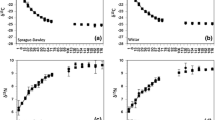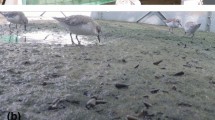Abstract
Stable isotopes have proven to be a useful tool for deciphering food webs, examining migration patterns and determining nutrient resource allocation. In order to increase the descriptive power of isotopes, an increasing number of studies are using them to model tissue turnover. However, these studies have, mostly by necessity, been largely limited to laboratory experiments and the demand for an easier method of estimating tissue turnover in the field for a large variety of organisms remains. In this study, we have determined the turnover rate of blood in mice and rats using stable isotope analysis, and compared these rates to the metabolic rates of the animals. Rats (Rattus norvegicus) (n=4) and mice (Mus musculus) (n=4) were switched between isotopically distinct diets, and the rate of change of δ13C and δ15N in whole blood was determined. Basal metabolic rates (as CO2 output and O2 consumption per unit time, normalized for mass) were determined for the rats and mice. Rats, which were an order of magnitude larger and had a slower metabolic rate per unit mass than mice (0.02 vs. 0.14 O2/min/g), had a slower blood turnover than mice for 13C (t 1/2 =24.8 and 17.3 days, respectively) and 15N (t 1/2 =27.7 and 15.4 days, respectively). A positive correlation between metabolic rate and blood isotopic turnover rate was found. These are the only such data for mammals available, but the literature for birds shows that mass and whole-body metabolic rates in birds scale logarithmically with tissue turnover. Interestingly, the mammalian data graph separately from the bird data on a turnover versus metabolic rate plot. Both mice and rat tissue in this study exhibited a slower turnover rate compared to metabolic rate than for birds. These data suggest that metabolic rate may be used to estimate tissue turnover rate when working with organisms in the field, but that a different relationship between tissue turnover and metabolism may exist for different classes of organisms.







Similar content being viewed by others
References
Arneson LS, MacAvoy SE (2005) Carbon, nitrogen and sulfur diet-tissue discrimination in mouse tissues. Can J Zool 83:989–995
Arneson LS, MacAvoy SE, Bassett E (2006) Metabolic protein replacement drives tissue turnover in adult mice. Can J Zool 84:983–993
Ayliffe LK, Cerling TE, Robinson T, West A, Sponheimer M, Passey B, Hammer J, Roeder B, Dearing MD, Ehleringer JR (2004) Turnover of carbon isotopes in tail hair and breath CO2 of horses fed an isotopically varied diet. Oecologia 139:11–22
Bearhop S, Waldron S, Votier SC, Furness RW (2002) Factors that influence assimilation rates and fractionation of nitrogen and carbon stable isotopes in avian blood and feathers. Physiol Biochem Zool 75:451–458
Bronham L, Rambaut A, Harvey P (1996) Determinants of rate variation in mammalian DNA sequence evolution. J Mol Evol 43:411–439
Carleton SA, del Rio CM (2005) The effect of cold-induced increased metabolic rate on the rate of 13C and 15N incorporation in house sparrows (Passer domesticus). Oecologia 144:226–232
Chamberlain CP, Blum JD, Holmes RT, Feng X, Sherry TW, Graves GR (1997) The use of isotope tracers for identifying populations of migratory birds. Physiol Biochem Zool 75:451–458
Evans-Ogden LJ, Hobson KA, Lank DB (2004) Blood isotopic (δ13C and δ15N) turnover and diet-tissue fractionation factors in captive dunlin (Calidris alpine pacifica). Auk 121:170–177
Frazer TK, Ross RM, Quetin LB, Montoya JP (1997) Turnover of carbon and nitrogen during growth of larval krill, Euphausia superba Dana: a stable isotope approach. J Exp Mar Biol Ecol 212:259–275
Fry B, Arnold C (1982) Rapid 13C/12C turnover during growth of brown shrimp (Penaeus aztecus). Oecologia 54:200–204
Fry B, Sherr EB (1984) δ13C measurements as indicators of carbon flow in marine and freshwater ecosystems. Contrib Mar Sci 27:13–47
Gannes LZ, O’Brien DM, del Rio CM (1997) Stable isotopes in animal ecology: assumptions, caveats, and a call for more laboratory experiments. Ecology 78:1271–1276
Haramis GM, Jorde DG, Macko SA, Walker JL (2001) Stable-isotope analysis of canvasback winter diet in upper Chesapeake Bay. Auk 118:1008–1017
Hart JS (1971) Rodents. In: Whittow GG (ed) Comparative physiology of thermoregulation, Academic, London, pp 1–149
Herzka SZ, Holt GJ (2000) Changes in isotopic composition of red drum (Sciaenops ocellatus) larvae in response to dietary shifts: potential applications to settlement studies. Can J Fish Aquat Sci 57:137–147
Hesslein RH, Hallard KA, Ramlal P (1993) Replacement of sulfur, carbon, and nitrogen in tissue of growing broad whitefish (Coregonus nasus) in response to a change in diet traced by δ34S, δ13C and δ15N. Can J Fish Aquat Sci 50:2071–2076
Heusner AA (1991) Size and power in mammals. J Exp Biol 160:25–54
Hobson KA (1999) Tracing origins and migration of wildlife using stable isotopes: a review. Oecologia 120:314–326
Hobson KA, Bairlein F (2003) Isotope fractionation and turnover in captive garden warblers (Sylvia borin): implications for delineating dietary and migratory associations in wild passerines. Can J Zool 81:1630–1635
Hobson KA, Clark RG (1992) Assessing avian diets using stable isotopes I: turnover of 13C in tissues. Condor 94:181–188
Hobson KA, Clark RG (1993) Turnover of 13C in cellular and plasma reactions of blood: implications for nondestructive sampling in avian dietary studies. Auk 110:638–641
Hobson KA, Stirling I (1997) Low variation in blood 13C among Hudson Bay polar bears: implications for metabolism and tracing terrestrial foraging. Mar Mamm Sci 13:359–367
Hobson KA, Wassenaar LI (1999) Stable isotope ecology: an introduction. Oecologia 120:312–313
Hobson KA, McLellan BN, Woods JG (2000) Using stable carbon (δ13C) and nitrogen (δ15N) isotope to infer trophic relationships among black and grizzly bears in the upper Columbia River basin, British Columbia. Can J Zool 78:1332–1339
Hobson KA, Schell SM, Renouf D, Noseworthy E (1995) Stable carbon and nitrogen isotopic fractionation between diet and tissues of captive seals: implications for dietary reconstructions involving marine mammals. Can J Fish Aquat Sci 53:528–533
Kleiber M (1932) Body size and metabolism. Hildargia 6:315–353
Kleiber M (1947) Body size and metabolic rate. Physiol Rev 27:511–541
Knoff AJ, Macko SA, Erwin RM, Brown KM (2002) Stable isotope analysis of temporal variation in the diets of pre-fledged laughing gulls. Waterbirds 25:142–148
Koch PL, Phillips DL (2002) Incorporating concentration dependence in stable isotope mixing models: a reply to Robbins, Hilderbrand and Farley (2002). Oecologia 133:14–18
Kojeta P (1991) On the relation between basal and field metabolic rates in birds and mammals. Funct Ecol 5:56–64
Lindstrom A (1997) Basal metabolic rates of migrating waders in the Eurasian Artic. J Avian Biol 28:87–92
Lovegrove BG (2003) The influence of climate on the basal metabolic rate of small mammals: a slow-fast metabolic continuum. J Comp Physiol B Biochem Environ Physiol 173:87–112
MacAvoy SE, Macko SA, Garman GC (2001) Isotopic turnover in aquatic predators: quantifying the exploitation of migratory prey. Can J Fish Aquat Sci 58:923–932
MacAvoy SE, Macko SA, Arneson LS (2005) Growth versus metabolic tissue replacement in mouse tissues determined by stable carbon and nitrogen isotope analysis. Can J Zool 83:631–641
Maruyama A, Yamada Y, Rusuwa B, Yuma M (2001) Change in stable nitrogen isotope ratio in the muscle tissue of a migratory goby, Rhinogobius sp., in a natural setting. Can J Fish Aquat Sci 58:2125–2128
McKechnie AE, Wolf BO (2004) The allometry of avian basal metabolic rate: good predictions need good data. Physiol Biochem Zool 77:502–521
McNabb BK (1988) Complications inherent in scaling the basal rate of metabolism in mammals. Q Rev Biol 63:25–54
Minagawa M, Wada E (1984) Stepwise enrichment of 15N along food chains: further evidence and the relation between δ15N and animal. Geochim Cosmochim Acta 48:1135–1140
Pearson SF, Levey DJ, Greenberg CH, del Rio CM (2003) Effects of elemental composition on the incorporation of dietary nitrogen and carbon isotopic signatures in an omnivorous songbird. Oecologia 135:516–523
Peterson BJ, Howarth RW (1987) Sulfur, carbon, and nitrogen isotopes used to trace organic matter flow in the salt-marsh estuaries of Sapelo Island, Georgia. Limnol Oceanograph 32:1195–1213
Phillips DL, Gregg JW (2003) Source partitioning using stable isotopes: coping with too many sources. Oecologia 136:261–269
Phillips DL, Koch PL (2002) Incorporating concentration dependence in stable isotope mixing models. Oecologia 130:114–125
Ricklefs RE, Konarzweski M, Daan S (1996) The relationship between basal metabolic rate and daily energy expenditure in birds and mammals. Am Nat 147:1047–1071
Roberts JR, Baudinette RV (1986) Thermoregulation, oxygen-consumption and water turnover in stubble quail, Coturnix pectoralis, and king quail, Coturnix chinensis. Aust J Zool 34:25–33
Sponheimer M, Robinson TF, Cerling TE, Tegland L, Roeder BL, Ayliffe L, Dearing MD, JR Erleringer (2006) Turnover of stable carbon isotopes in the muscle, liver, and breath CO2 of alpacas (Lama pacos). Rapid Commun Mass Spectrom 20:1395–1399
Tieszen LL, Farge T (1993) Effect of diet quality and composition on the isotopic composition, CO2, bone collagen, bioapatite, and soft tissues. In: Lambert J, Groupe G (eds) Molecular archeology of prehistoric human bone. Springer, Berlin Heidelberg New York, pp 123–135
Tieszen LL, Boutton TW, Tesdahl KG, Slade NA (1983) Fractionation and turnover of stable carbon isotopes in animal tissues: implications for δ13C analysis of diet. Oecologia 57:32–37
Vander Zanden MJ, Cabana G, Rasmussen JB (1997) Comparing trophic position of freshwater fish calculated using stable nitrogen isotope ratios (δ15N) and literature dietary data. Can J Fish Aquat Sci 54:1142–1158
Voigt CC, Matt F, Michener R, Kunz TH (2003) Low turnover rates of carbon isotopes in tissues of two nectar-feeding bat species. J Exp Biol 206:1419–1427
White CR, Seymour RS (2003) Mammalian basal metabolic rate is proportional to body mass2/3. Proc Natl Acad Sci USA 100:4046–4049
Woodin M, Stephenson R (1998) Circadian rhythms in diving behavior and ventilatory response to asphyxia in canvasback ducks. Am J Physiol 274:R686–R692
Acknowledgments
The authors would like to thank the COSMOS Foundation and the Mellon Fund (American University) for partial funding of this study, and two anonymous reviewers for their constructive comments. The experiments described in this paper comply with the current laws of the United States.
Author information
Authors and Affiliations
Corresponding author
Additional information
Communicated by Jim Ehleringer.
Rights and permissions
About this article
Cite this article
MacAvoy, S.E., Arneson, L.S. & Bassett, E. Correlation of metabolism with tissue carbon and nitrogen turnover rate in small mammals. Oecologia 150, 190–201 (2006). https://doi.org/10.1007/s00442-006-0522-0
Received:
Accepted:
Published:
Issue Date:
DOI: https://doi.org/10.1007/s00442-006-0522-0




